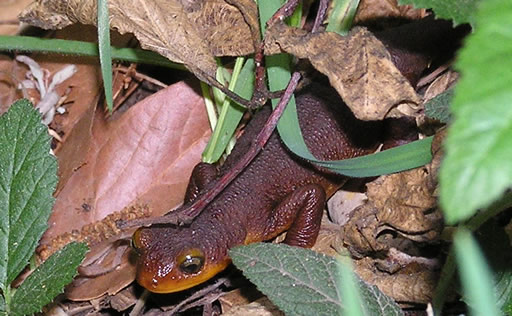Everyone associates the poison or “dart” frogs (Family Dendrobatidae) with skin toxins, but it is to the slow, seemingly benign newts and salamanders that we should really pay heed. In many cases their toxins are far more virulent and, unlike those of the poison frogs, they are produced internally and are not dependent upon diet for their existence (in other words, the toxins do not decline after a time in captivity, as is the case for poison frogs!).
One of Earth’s Most Toxic Creatures
 Over 200 compounds, some of which are medically significant, have been isolated from newt and salamander skins. Western North America’s rough-skinned newt (Taricha granulosa) possesses what may very well be the salamander world’s most powerful secretions…a single adult packs enough to kill 25,000 mice. More than one person (usually male, drunk and involved in some sort of “initiation” or dare), has suffered fatal consequences after swallowing a rough-skinned newt.
Over 200 compounds, some of which are medically significant, have been isolated from newt and salamander skins. Western North America’s rough-skinned newt (Taricha granulosa) possesses what may very well be the salamander world’s most powerful secretions…a single adult packs enough to kill 25,000 mice. More than one person (usually male, drunk and involved in some sort of “initiation” or dare), has suffered fatal consequences after swallowing a rough-skinned newt.
Skin secretions entering tiny cuts have rendered researcher’s limbs numb for hours, and a scientist who rubbed his eyes after touching a “woodland salamander” (I cannot recall the species, but belonging to the red-backed/slimy salamander group) wandered about blind for nearly 3 days before being rescued.
Toxins vs. Eel
 Although the California newt’s (Taricha torosa) toxins pale in comparison to those of its rough-skinned cousin, they are not to be trifled with. I kept a California newt with an American eel for 17 years. The eel, a voracious predator that would as soon latch onto my hand as anything else, never once molested its seemingly defenseless tank-mate.
Although the California newt’s (Taricha torosa) toxins pale in comparison to those of its rough-skinned cousin, they are not to be trifled with. I kept a California newt with an American eel for 17 years. The eel, a voracious predator that would as soon latch onto my hand as anything else, never once molested its seemingly defenseless tank-mate.
Next time I’ll relate an encounter I generated as a foolish 13 year old working in a pet store, which clearly illustrates the toxicity of even the most familiar of North American newts.
Further Reading
You can read more about the natural history and toxicity of the rough-skinned newt at http://www.amphibiaweb.org/cgi/amphib_query?where-genus=Taricha&where-species=granulosa&account=amphibiaweb
California Newt Image referenced from Wikipedia Commons and originally posted by Justin Johnsen
 That Reptile Blog – Reptile, Amphibian and Exotic Pet Care and Information
That Reptile Blog – Reptile, Amphibian and Exotic Pet Care and Information

 Lengthening days and warmer temperatures are beginning to register on amphibian pets nationwide, stirring long-dormant breeding urges. Last week I was please to find that a 2 year old female axolotl (Ambystoma mexicanum) which I paired with an older male had produced eggs for the first time. A week or so earlier a reader informed me of another spontaneous axolotl breeding.
Lengthening days and warmer temperatures are beginning to register on amphibian pets nationwide, stirring long-dormant breeding urges. Last week I was please to find that a 2 year old female axolotl (Ambystoma mexicanum) which I paired with an older male had produced eggs for the first time. A week or so earlier a reader informed me of another spontaneous axolotl breeding. Axolotl eggs are typically attached to plants or other structures, as seen in the accompanying photo. Once they begin to hatch, I’ll add additional plants, nearly filling the tank so as to separate the larvae a bit and reduce cannibalism.
Axolotl eggs are typically attached to plants or other structures, as seen in the accompanying photo. Once they begin to hatch, I’ll add additional plants, nearly filling the tank so as to separate the larvae a bit and reduce cannibalism.  The many fire salamanders I have kept would, without exception, leave their retreats in anticipation of food when I approached their terrarium. Most feed from the fingers or forceps and are not shy about moving about in broad daylight once they are acclimatized to captivity. They even move differently than most salamanders – holding their bodies high off the group and “stomping about” in a very determined (and most “un-salamander-like”) manner. And, as you can see from the photo, their bold personalities also suit them well as “amphibian ambassadors” to budding herpetologists!
The many fire salamanders I have kept would, without exception, leave their retreats in anticipation of food when I approached their terrarium. Most feed from the fingers or forceps and are not shy about moving about in broad daylight once they are acclimatized to captivity. They even move differently than most salamanders – holding their bodies high off the group and “stomping about” in a very determined (and most “un-salamander-like”) manner. And, as you can see from the photo, their bold personalities also suit them well as “amphibian ambassadors” to budding herpetologists! Adult axolotls are sexually dimorphic, with females being of a heavier build and having shorter and broader heads than males. The cloaca of the male is noticeably swollen during the breeding season, and gravid females become very plump.
Adult axolotls are sexually dimorphic, with females being of a heavier build and having shorter and broader heads than males. The cloaca of the male is noticeably swollen during the breeding season, and gravid females become very plump. Please see
Please see